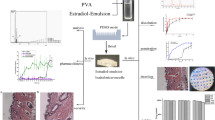Abstract
Purpose. The aim of our study was to clarify the kinetic performance of a membrane controlled reservoir system (MCRS) for β-estradiol (E2) under in vitroconditions by determination of the role of membrane and adhesive layer on E2flux control.
Methods. E2and ethanol fluxes across EVA membrane or membrane coated with adhesive from saturated solutions in defined ethanol/PBS mixtures were measured in the symmetric and asymmetric configuration. Physicochemical parameters of the EVA membrane were determined.
Results. The E2flux across the 9% EVA membrane steadily increased with increasing ethanol concentrations in both configurations, due to enhanced uptake of E2by the polymer and increasing membrane diffusivity. Permeation across the EVA membrane coated with an adhesive layer in the symmetric and asymmetric configuration increased up to maximum values of 0.80 ± 0.14 (μg × cm−2× h−1and 0.37 ± 0.02 μg × cm−2× h−1, respectively, at 62.5% (v/v) ethanol. The fluxes then decreased with further increase in the volume fraction of ethanol due to a dramatically reduced permeability of the adhesive layer. For the asymmetric case, a linear dependence of E2on ethanol fluxes was observed.
Conclusions. The E2flux from MCRS is strictly dependent on reservoir ethanol concentrations, whereas the adhesive layer represents the rate controlling barrier at high ethanol levels (>70% v/v).
Similar content being viewed by others
REFERENCES
J. A. Balfour and R. C. Heel. Transdermal estradiol: A review of its pharmacodynamic properties and therapeutic efficacy in the treatment of menopausal complaints. Drugs 40:561-582 (1990).
L. R. Laufer, J. L. de Fazio, and J. K. L. Lu. Estrogen replacement therapy by transdermal estradiol administration. Am. J. Obstet. Gynecol. 146:533-539 (1983).
W. R. Good, M. S. Powers, P. Campbell, and L. Schenkel. A new transdermal delivery system for 17 β-Estradiol. J. Contr. Rel. 2:89-94 (1985).
I. Setnikar, L. C. Rovati, B. Vens-Cappell, and C. Hilgenstock. Bioavailabilty of estradiol from two transdermal patches. Arzneim.-Forsch./Drug Res. 46:307-310 (1995).
S. F. Gordon. Clinical experience with a seven-day estradiol transdermal system for estrogen replacement therapy. Am. J. Obstet. Gynecol. 173:998-1004 (1995).
U. D. Rohr, C. Nauert, and A. M. Ehrly. Kinetik eines neuen Pflaters zur transdermalen Applikation von 17 β-Estradiol. Zentralbl. Gynakol. 117:531-539 (1995).
Y. Le Roux, M. L. Borg, M. Sibille, J. Thebault, A. Renoux, M. J. Douin, F. Djebbar, and M. P. Dain. Bioavailability study of Menorest®a new estrogen transdermal delivery system, compared with a transdermal reservoir system. Clin. Drug Invest. 10:172-178 (1995).
U. D. Rohr, R. Altenburger, and T. Kissel. Kinetics of the transdermal reservoir membrane system delivering β-estradiol: In vitro/in vivo correlation. Pharm. Res. 15:875-884 (1998).
P. S. Campbell and S. K. Chandrasekaran. US Patent 4379454.
R. W. Baker and J. Heller. Materials selections for transdermal delivery systems. In: J. Hadgraft and R. H. Guy (Eds.). Transdermal drug delivery. Marcel Dekker, New York, 1989, pp. 293-311.
R. D. Smith, D. E. Robinson, B. Delignieres, B. D. Albertson, T. P. Tomai, M. J. Zinaman, and J. A. Simon. Effects of vehicle supplementation on total estradiol absorption from a transdermal estradiol delivery system. Fertil. Steril. 56:1029-1033 (1991).
P. Liu, T. Kurihara-Bergstrom, and W. R. Good. Cotransport of estradiol and ethanol through human skin in vitro: Understanding the permeant/enhancer flux relationship. Pharm. Res. 8:938-944 (1991).
A. H. Ghanem, H. Mahmoud, W. I. Higuchi, U. D. Rohr, S. Borsadia, P. Liu, J. L. Fox, and W. R. Good. The effects of ethanol on the transport of β-estradiol and other permeants in hairless mouse skin II: A new quantitative approach. J. Contr. Rel. 6:75-83 (1987).
N. A. Megrab, A. C. Williams, and B. W. Barry. Oestradiol permeation across human skin, silastic and snake skin membranes: The effects of ethanol/water co-solvent systems. Int. J. Pharm. 116:101-112 (1995).
D. D. Kim, J. L. Kim, and Y. W. Chien. Mutual hairless rat skin permeation-enhancing effect of ethanol/water system and oleic acid. J. Pharm. Sci. 85:1191-1195 (1996).
G. S. Chen, D. D. Kim, and Y. W. Chien. Dual-controlled transdermal delivery of levonorgestrel and estradiol: Enhanced permeation and modulated delivery. J. Contr. Rel. 34:129-143 (1994).
T. Kurihara-Bergstrom, K. Knutson, L. J. DeNoble, and C. Y. Goates. Percutaneous absorption enhancement of am ionic molecule by ethanol-water systems in human skin. Pharm. Res. 7:762-766 (1990).
S. I. Yum, E. S. Lee, L. Taskovich, and F. Theeuwes. Mechanism of action of ethanol as flux enhancer for drug permeation through human skin. Proc. Int. Symp. Control. Rel. Bioactive Mater. 14:103-104 (1987).
R. M. Gale and R. G. Berggen. US Patent 4615699 (1986).
R. M. Gale, E. S. Lee, L. T. Taskovich, and S. I. Yum. US Patent 4588580 (1986).
T. Higuchi. Physical chemical analysis of percutaneous absorption process from creams and ointments. J. Soc. Cosmet. Chem. 11:85-97 (1960).
B. Berner, J. H. Otte, G. C. Mazzenga, R. J. Steffens, and C. D. Ebert. Ethanol:water mutually enhanced transdermal therapeutic system I: Nitroglycerin solution properties and membrane transport. J. Pharm. Sci. 78:314-318 (1989).
L. K. Pershing, G. E. Parry, and L. D. Lambert. Disparity of in vitro and in vivo oleic acid-enhanced β-estradiol percutaneous absorption across human skin. Pharm. Res. 10:1745-1750 (1993).
L. K. Pershing, L. D. Lambert, and K. Knutson. Mechanism of ethanol-enhanced permeation across human skin in vivo. Pharm. Res. 7:170-175 (1990).
P. Liu, WQ. I. Higuchi, A. H. Ghanem, J. L. Fox, T. Kurihara-Bergstrom, and W. R. Good. Influence of ethanol on diffusion/metabolism of β-estradiol in hairless mouse skin for the “asymmetric” situation. Proc. Int. Symp. Control. Rel. Bioactive Mater. 16:35-36 (1989).
Author information
Authors and Affiliations
Rights and permissions
About this article
Cite this article
Altenburger, R., Rohr, U.D. & Kissel, T. Rate Control in Transdermal β-Estradiol Reservoir Membrane Systems: The Role of Membrane and Adhesive Layer. Pharm Res 15, 1238–1243 (1998). https://doi.org/10.1023/A:1011944025262
Issue Date:
DOI: https://doi.org/10.1023/A:1011944025262




